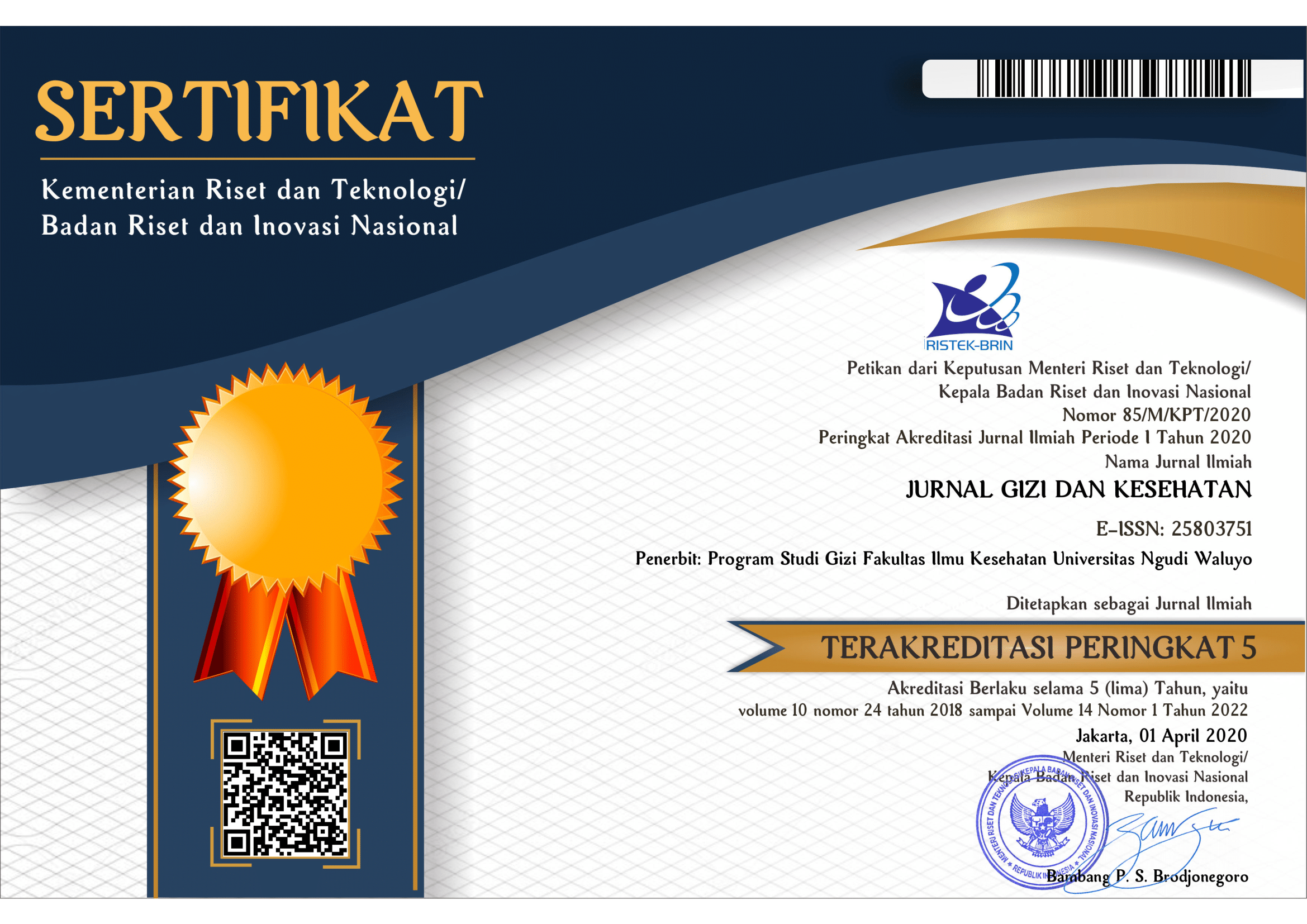The Effect of Fermentation Time on Protein and Fat Content in The Red Beans (Phaseolus Vulgaris L.) Tempeh
DOI:
https://doi.org/10.35473/jgk.v13i2.236Keywords:
fermentation time, protein, fat, red beans tempehAbstract
Red beans is one of the local foods that is included in the type of legume and has a high nutrition content of vegetable protein and low fat. Red beans can be processed into red beans tempeh, with a fermentation time treatment that can affect protein and fat levels. This research aims to describes the protein and fat content in fermented red beans tempeh for 3 days. This study uses Experimental Design research using a one-shot case study design, which is to provide treatment time of red beans tempeh for 3 days, each 3 pieces of tempeh / day with each treatment using 100 grams of red beans mixed with 0.1 gram of yeast tempeh Rhizopus sp. Tempeh that has been formed will be analyzed for the nutritional content of protein and fat.The result showed that the protein content in red beans tempeh on day 2 contained as much protein (13.64 grams), on day 3 (13.64 grams) and on day 4 (9.64 grams). While the fat content in red beans tempeh on day 2 is (0.62 grams), day 3 (1.11 grams) and day 4 (1.14 grams). The protein and fat content in red beans tempeh, the longer the fermentation, the more it will affect the nutrients.
Downloads
References
Ayu, DE (2010). "Chemical and Sensory Characteristics of Tempe with Variations of Soybean / Rice Raw Materials and Addition of Numbers and Variations of Fermentation Time". [Essay]. Faculty of Agriculture, Sebelas Maret University, Surakarta.
Central Bureau of Statistics. (2018). Indonesian Seasonal Vegetable and Fruit Crop Statistics.
Fazriwati, A., Widiastuti, A., Yuliani, NI, and Agustini, R. (2014). "Making Tempe and Tofu Made From Raw Red Beans as Food Alternatives with High Nutrient Content". [PKM Research]. Muhammadiyah University Jakarta.
Hardiansyah., And Supariasa, IDN (2017). Nutritional Sciences: Theory & Applications. Jakarta: Medical books: EGC.
Kay, Daisy E. (1979). Food Legumes.London: Tropical Products Institute.
Ministry of Agriculture. (2014). Horticultural Production Statistics, 2013. Jakarta: Director General of Horticulturalism.
Indonesian Ministry of Health. (2018). Table of Indonesian Food Composition 2017. Jakarta: Directorate General of Public Health, Directorate of Public Nutrition.
Lusiyati, NT (2014). "Test of Fiber, Protein and Organoleptic Properties in Tempe from the Basic Material of Red Beans (Phaseolus vulgaris L) with Addition of Corn and Bran". [Essay]. Faculty of Teacher Training and Education, Muhammadiyah University of Surakarta.
MacKay, DJ, and Miller, AL (2003). “Nutritional Support for Wound Healing.” J Alternatie Medicine Review. 8, (4), 359-377.
Mahan, KL, Escott-Stump. (2008). Krause's Food and Nutrition Therapy. Canada: Elsevier: Edition 12.
Maharani, AY, Nasrul, RH, Sri, H., Dewi, EA, Ria, N., and Syaiful, F. (2016). "The Effect of Long Fermentation Against Protein Levels of Durian Seed Tempe". Florea.Vol 3.No. 2.
Maryam, S. (2016). "Components of Red Beans Tempe Isoflavones (Phaseolus vulgaris L) in Various Fermentation Periods". Seminar Journal. 4 (1): 1-13.
Muthmainna, SMS, and Supriadi. (2016). "The Effect of Fermentation Time on Protein Content of Tempe, Lamtoro Gung (Leucaena leucocephala) Fruit Seeds". J. Contract. Kim. Vol. 5.No. 1.
Mutmainah, S., Ana, US, Septani, BA, Lailatul, M., Hapsari, TP (2019). "Effect of Red Beans Fermentation Process (Phaseolus vulgaris L.) using tempeh yeast (Rhizopus sp.) And the enzyme papain on the quality of red bean sausage". Food Technology. Vol. 10.No. 2.
Notoadmodjo, S. (2010). Health Research Methodology. Jakarta: PT. Rineka Cipta.
Pagarra, H. (2011). "The Effect of Boiling Time on Protein Content of Cowpea Tempe (Vigna Unguiculata)". Bionature.Vol. 12.No.1.
Regulation of the Minister of Health of the Republic of Indonesia. (2019). Nutritional Adequacy Rate Table. Jakarta: Minister of Health of the Republic of Indonesia.
Sulistyowati, E., Retno, A., and Das, S. (2004). "Study of the Old Effect of Soy Tempe Fermentation on Trypsin Activity". [Research Report]. Faculty of Mathematics and Natural Sciences, Yogyakarta State University.
Wicaksono, AT (2014). "Effect of Thickness and Percent of Package Aeration on Physicochemical Properties of Red Beans Tempe Grits (Phaseolus vulgaris L)". Agroindustry Technology.
Widyaningsih, TD, Wijayanti, N., and Nugrahini, NIP (2017). Functional Food: Health Aspects, Evaluation and Regulation. Printing 1.Malang: Brawijaya University.
Winarno, FG (2002). Food Chemistry and Nutrition. Jakarta: PT. Gramedia Pustaka Utama.
Yulia, R., Arif, H., Amri, A., and Sholihati. (2019). "The Effect of Yeast Concentration and Time of Fermentation on Water Content, Protein and Organoleptic Content in Tempe from Melinjo Seeds (Gnetum gnemon L)". Rona Journal of Agricultural Engineering. Vol 12. No 1.










